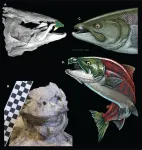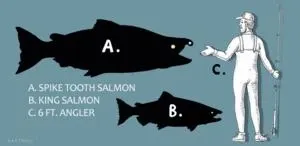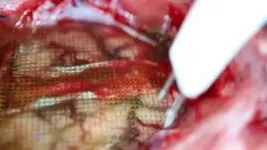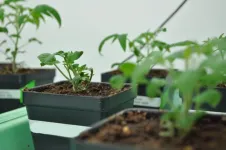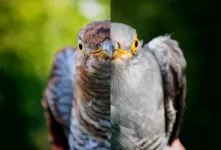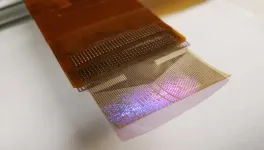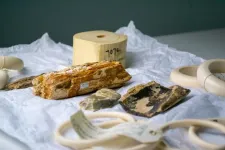(Press-News.org) Oncorhynchus rastrosus, a giant species of salmon that lived in the North American Pacific Northwest a few million years ago, sported a pair of front teeth that projected out from the sides of its mouth like tusks, according to a study published April 24 in the open-access journal PLOS ONE by Kerin Claeson from the Philadelphia College of Osteopathic Medicine, USA, and colleagues.
O. rastrosus, first described in the 1970s, has been estimated to reach up to 2.7 meters (8.9 feet) long, making it the largest member of the Salmonidae family ever discovered. Initially, researchers thought its oversized front teeth pointed backward into the mouth like fangs, in large part because fossils of the teeth were found apart from the rest of the skull. This led to the common name “saber-toothed salmon.” But through new CT scans and analysis of various Oncorhynchus rastrosus fossils collected over the years, researchers have now been able to confirm that the teeth actually pointed sideways out of the fish’s mouth, similar to a warthog. As a result, the authors say, the species should be renamed the “spike-toothed salmon.”
While it’s unclear exactly what these teeth may have been used for, the researchers believe they were likely used for fighting — either against other spiked-toothed salmon or as a defense against predators — or as a tool for digging out nests. It’s also possible the teeth were used for multiple purposes, the authors note. But the teeth likely weren’t used for catching prey, since Oncorhynchus rastrosus is believed to have been a filter-feeder that dined on plankton.
Kerin Claeson, lead author and professor of anatomy at Philadelphia College of Osteopathic Medicine, adds: "We have known for decades that these extinct salmon from Central Oregon were the largest to ever live. Discoveries like ours show they probably weren't gentle giants. These massive spikes at the tip of their snouts would have been useful to defend against predators, compete against other salmon, and ultimately build the nests where they would incubate their eggs."
Edward Davis, associate professor of earth sciences at the University of Oregon and director of Condon Collection at the UO’s Museum of Natural and Cultural History, adds: “I’m delighted that we have been able to put a new face on the giant spike-tooth salmon, bringing knowledge from the field in Oregon to the world.”
Brian Sidlauskas, professor and curator of fishes at Oregon State University, adds: “We also stress that females and males alike possessed the enormous, tusk-like teeth. Therefore, the sexes were equally fearsome.”
#####
In your coverage please use this URL to provide access to the freely available article in PLOS ONE: https://journals.plos.org/plosone/article?id=10.1371/journal.pone.0300252
Citation: Claeson KM, Sidlauskas BL, Troll R, Prescott ZM, Davis EB (2024) From sabers to spikes: A newfangled reconstruction of the ancient, giant, sexually dimorphic Pacific salmon, †Oncorhynchus rastrosus (SALMONINAE: SALMONINI). PLoS ONE 19(4): e0300252. https://doi.org/10.1371/journal.pone.0300252
Author Countries: USA, Canada
Funding: This work was supported by the National Science Foundation (1948340 and 2228394, awarded to ED). The funders had no role in study design, data collection and analysis, decision to publish, or preparation of the manuscript.
END
These giant, prehistoric salmon had tusk-like teeth
Paleontologists believe the teeth may have been used for defense, competitive fighting, or as digging tools
2024-04-24
ELSE PRESS RELEASES FROM THIS DATE:
New study infers our wellbeing by analyzing the language we use around ageing, using language markers to enable "a different type of access to individuals’ inner worlds"
2024-04-24
New study infers our wellbeing by analyzing the language we use around ageing, using language markers to enable "a different type of access to individuals’ inner worlds"
###
Article URL: https://journals.plos.org/plosone/article?id=10.1371/journal.pone.0302103
Article Title: When I am sixty-four… evaluating language markers of well-being in healthy aging narratives
Author Countries: Switzerland, USA, Australia
Funding: Funding by the Jacobs Foundation (https://jacobsfoundation.org/en/; awarded to TM) and the Swiss National Science Foundation SNF ((https://www.snf.ch/en/; fellowship P2ZHP1_199409 ...
New research confirms plastic production is directly linked to plastic pollution
2024-04-24
APRIL 24, 2024 – A research paper published today in Science Advances reveals a direct correlation between plastic production and plastic pollution, such that every 1% increase in plastic production is associated with a 1% increase in plastic pollution in the environment. The study finds that fast-moving consumer goods companies disproportionately contribute to the problem more than household and retail companies. The study marks the first robust quantification of the global relationship between plastic production and pollution.
The research, led by scientists ...
MSU researchers uncover 'parallel universe' in tomato genetics
2024-04-24
In a new paper appearing in Science Advances, Michigan State University researchers have unraveled a surprising genetic mystery centered on sugars found in what gardeners know as “tomato tar.”
Anyone who has pruned tomato plants barehanded has likely found their fingers darkened with a sticky, gold-black substance that won’t quite wash off.
This tomato tar is sticky for good reason. It’s made of sugars — acylsugars, to be precise — and acts as a sort of natural flypaper for ...
Grey cuckoo, red cuckoo: unveiling the genomic secrets of color polymorphism in female cuckoo birds
2024-04-24
NEW YORK, April 24, 2024 — Sexual dimorphism—the visible difference between females and males—can be seen in diverse animals, including humans. One intriguing aspect of this phenomenon is sex-limited polymorphism, where one sex displays greater variations in a particular trait than the other. In a recent study published in Science Advances, a team of researchers delve into the genetic underpinnings behind the color polymorphism observed in adult females of the brood parasitic Cuculus, more widely known as cuckoo birds, shedding light on the evolution and functional significance of this phenomenon.
Several species of cuckoos, a genus of birds ...
CHOP researchers discover underlying biology behind Fontan-associated liver disease
2024-04-24
Philadelphia, April 24, 2024 – As patients with congenital heart diseases live longer, researchers are attempting to understand some of the other complications they may face as they age. In a new study, a team from Children’s Hospital of Philadelphia (CHOP) used state-of-the-art technologies to understand the underlying biology of Fontan-associated liver disease (FALD).
The findings, published today in Science Translational Medicine, reveal unprecedented insights into how the disease develops and potential therapeutic targets for future treatment options.
The Fontan operation is ...
A flexible microdisplay can monitor brain activity in real-time during brain surgery
2024-04-24
A thin film that combines an electrode grid and LEDs can both track and produce a visual representation of the brain’s activity in real-time during surgery–a huge improvement over the current state of the art. The device is designed to provide neurosurgeons visual information about a patient’s brain to monitor brain states during surgical interventions to remove brain lesions including tumors and epileptic tissue.
Each LED in the device mirrors the activity of a few thousand neurons. In a series of proof-of-concept experiments in rodents and large non-primate mammals, researchers showed that ...
Diversity and productivity go branch-in-branch
2024-04-24
Kyoto, Japan -- Climate change can be characterized as the Grim Reaper or some other harbinger of dire times for humanity and natural environment, including forests. Previous studies reporting a decline in forest productivity due to climate warming and long-term drought may suggest that trees' survival hangs in the balance.
Now, a study by an international group, including Kyoto University, found that forests with higher trait diversity not only adapt better to climate change but may also thrive.
The study, conducted by researchers from Lakehead ...
Color variants in cuckoos: the advantages of rareness
2024-04-24
Every cuckoo is an adopted child – raised by foster parents, into whose nest the cuckoo mother smuggled her egg. The cuckoo mother is aided in this subterfuge by her resemblance to a bird of prey. There are two variants of female cuckoos: a gray morph that looks like a sparrowhawk, and a rufous morph. Male cuckoos are always gray.
“With this mimicry, the bird imitates dangerous predators of the host birds, so that they keep their distance instead of attacking,” says Professor Jochen Wolf from LMU Munich. Together with researchers at CIBIO (Centro de Investigação ...
Laser technology offers breakthrough in detecting illegal ivory
2024-04-24
A new way of quickly distinguishing between illegal elephant ivory and legal mammoth tusk ivory could prove critical to fighting the illegal ivory trade. A laser-based approach developed by scientists at the Universities of Bristol and Lancaster, could be used by customs worldwide to aid in the enforcement of illegal ivory from being traded under the guise of legal ivory. Results from the study are published in PLOS ONE today [24 April].
Despite the Convention on the International Trade in Endangered Species (CITES) ban on ivory, poaching associated with its illegal trade has ...
Why can’t robots outrun animals?
2024-04-24
Robotics engineers have worked for decades and invested many millions of research dollars in attempts to create a robot that can walk or run as well as an animal. And yet, it remains the case that many animals are capable of feats that would be impossible for robots that exist today.
“A wildebeest can migrate for thousands of kilometres over rough terrain, a mountain goat can climb up a literal cliff, finding footholds that don't even seem to be there, and cockroaches can lose a leg and not slow down,” ...
LAST 30 PRESS RELEASES:
Making lighter work of calculating fluid and heat flow
Normalizing blood sugar can halve heart attack risk
Lowering blood sugar cuts heart attack risk in people with prediabetes
Study links genetic variants to risk of blinding eye disease in premature infants
Non-opioid ‘pain sponge’ therapy halts cartilage degeneration and relieves chronic pain
AI can pick up cultural values by mimicking how kids learn
China’s ecological redlines offer fast track to 30 x 30 global conservation goal
Invisible indoor threats: emerging household contaminants and their growing risks to human health
Adding antibody treatment to chemo boosts outcomes for children with rare cancer
Germline pathogenic variants among women without a history of breast cancer
Tanning beds triple melanoma risk, potentially causing broad DNA damage
Unique bond identified as key to viral infection speed
Indoor tanning makes youthful skin much older on a genetic level
Mouse model sheds new light on the causes and potential solutions to human GI problems linked to muscular dystrophy
The Journal of Nuclear Medicine ahead-of-print tip sheet: December 12, 2025
Smarter tools for peering into the microscopic world
Applications open for funding to conduct research in the Kinsey Institute archives
Global measure underestimates the severity of food insecurity
Child survivors of critical illness are missing out on timely follow up care
Risk-based vs annual breast cancer screening / the WISDOM randomized clinical trial
University of Toronto launches Electric Vehicle Innovation Ontario to accelerate advanced EV technologies and build Canada’s innovation advantage
Early relapse predicts poor outcomes in aggressive blood cancer
American College of Lifestyle Medicine applauds two CMS models aligned with lifestyle medicine practice and reimbursement
Clinical trial finds cannabis use not a barrier to quitting nicotine vaping
Supplemental nutrition assistance program policies and food insecurity
Switching immune cells to “night mode” could limit damage after a heart attack, study suggests
URI-based Global RIghts Project report spotlights continued troubling trends in worldwide inhumane treatment
Neutrophils are less aggressive at night, explaining why nighttime heart attacks cause less damage than daytime events
Menopausal hormone therapy may not pose breast cancer risk for women with BRCA mutations
Mobile health tool may improve quality of life for adolescent and young adult breast cancer survivors
[Press-News.org] These giant, prehistoric salmon had tusk-like teethPaleontologists believe the teeth may have been used for defense, competitive fighting, or as digging tools
